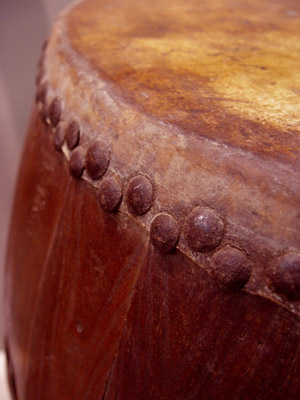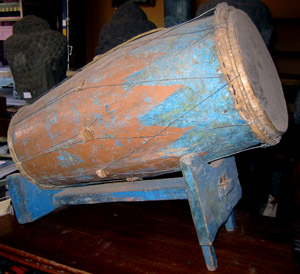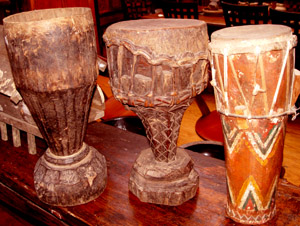 I find myself more and more attracted to folk instruments of Asia and the “Islands,” especially the drums. As a kid (and this hasn’t changed much) I couldn’t dance because I couldn’t hear the beat of the music. Imagine doing the waltz or cha-cha “rhythm-deaf.” Anyway, drums had never been my thing, but all that’s changed now.
I find myself more and more attracted to folk instruments of Asia and the “Islands,” especially the drums. As a kid (and this hasn’t changed much) I couldn’t dance because I couldn’t hear the beat of the music. Imagine doing the waltz or cha-cha “rhythm-deaf.” Anyway, drums had never been my thing, but all that’s changed now.
With village or tribal drums, there are four things I find irresistible. First is the form. The drums from Thailand are often tall (up to 8′) and have hour glass shapes, while Indonesian drums vary widely from tribe to tribe, island to island. They are pure sculpture, usually carved from solid logs. I’m a sculptor by training, and find the simplicity of these drums both alluring and fulfilling.
 Second is the color. The drums from Thailand have more elaborate forms and are either left as natural wood or painted simply red and black, blue, red and green or just black, while the Balinese and Javanese drums, with their simple forms, are all about color–layers and layers of color with the bits of 10 layers of paint showing through here and there. You can imagine the villager thinking, “it’s about time to paint the drum again. It’s looking a bit beat up…. maybe red this year.”
Second is the color. The drums from Thailand have more elaborate forms and are either left as natural wood or painted simply red and black, blue, red and green or just black, while the Balinese and Javanese drums, with their simple forms, are all about color–layers and layers of color with the bits of 10 layers of paint showing through here and there. You can imagine the villager thinking, “it’s about time to paint the drum again. It’s looking a bit beat up…. maybe red this year.”
The third irresistible aspect is the sound. I may be rhythm-deaf, but not tone deaf. They sound great. I often hear Justin demonstrating the drums through the floorboards of my upstairs office. It always makes me smile and conjures up visions of village life.
 The fourth and possibly the most important is the energy; the good vibe that is exuded from these drums. Though they are used for all sorts of ceremonies rituals and celebrations, they have a happy feeling. They are mostly about fun, family and community and dancing with friends. These drums, like people, like to hang out in groups. I watch with wonder, as my collection of drums at home grows.
The fourth and possibly the most important is the energy; the good vibe that is exuded from these drums. Though they are used for all sorts of ceremonies rituals and celebrations, they have a happy feeling. They are mostly about fun, family and community and dancing with friends. These drums, like people, like to hang out in groups. I watch with wonder, as my collection of drums at home grows.